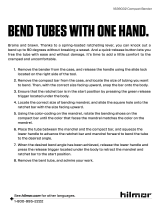Translation of the Original Instructions
Contents
1. Range of Equipment Supplied .................................................................................................... 1
2. Technical data ............................................................................................................................ 1
3. Operative range .......................................................................................................................... 1
4. Commissioning ........................................................................................................................... 2
5. Stroke Limiter (required for bending) .......................................................................................... 3
Switching from bending to cutting/perforating (stroke limiter Off; from U to V) ........................... 3
Switching from cutting/perforating to bending (stroke limiter On; from V to U) ........................... 3
6. Cutting ........................................................................................................................................ 4
Installing the blade ....................................................................................................................... 4
Cutting ......................................................................................................................................... 4
7. Perforating .................................................................................................................................. 5
Instructions for using the tools ..................................................................................................... 5
Installing the upper and lower tools ............................................................................................. 5
Installing the perforating tool ....................................................................................................... 6
Perforating without the hole template .......................................................................................... 7
Perforating with the hole template for DIN perforations .............................................................. 8
8. Bending ....................................................................................................................................... 9
Installing the bending device ....................................................................................................... 9
Bending ........................................................................................................................................ 9
9. Perforating tools for laminated copper and flat bars less than 34 mm wide ............................ 11
Operative range .........................................................................................................................11
Assembly ...................................................................................................................................12
Disassembly ..............................................................................................................................12
10. Adjustable template, order no.: 31890, for perforating tool ...................................................... 13
Adjusting the hole template .......................................................................................................13
Inserting the hole template ........................................................................................................14
Perforating .................................................................................................................................14
11. Swan-neck Bending Tools ........................................................................................................ 15
Operative range .........................................................................................................................15
Installing the swan-neck bending tool .......................................................................................15
Bending ......................................................................................................................................15
Tables for swan-neck bending tools ..........................................................................................16
Swan-neck bending tool (small), order no.: 31425 ....................................................................16
Swan-neck bending tool (small), order no.: 31646 ....................................................................17
12. Additional Bending Tool for Small Lug Lengths, Order No.: 31636 ......................................... 18
Operative range .........................................................................................................................18
Installing the additional bending tool .........................................................................................18
Installing the bending tool ..........................................................................................................19
Bending ......................................................................................................................................19
13. 60mm U bending tool, order no. 42430 .................................................................................... 20
Range of application ..................................................................................................................20
Installing the U bending tool ......................................................................................................20
Bending ......................................................................................................................................22
Removing the U bending tool ....................................................................................................22
14. Lamella cutter, order no.: 45445............................................................................................... 23
Range of application ..................................................................................................................23
Installing the lamella cutter ........................................................................................................23
Cutting .......................................................................................................................................24
15. Maintenance ............................................................................................................................. 25
SLB 125 .....................................................................................................................................25
Perforating tool ..........................................................................................................................25






















